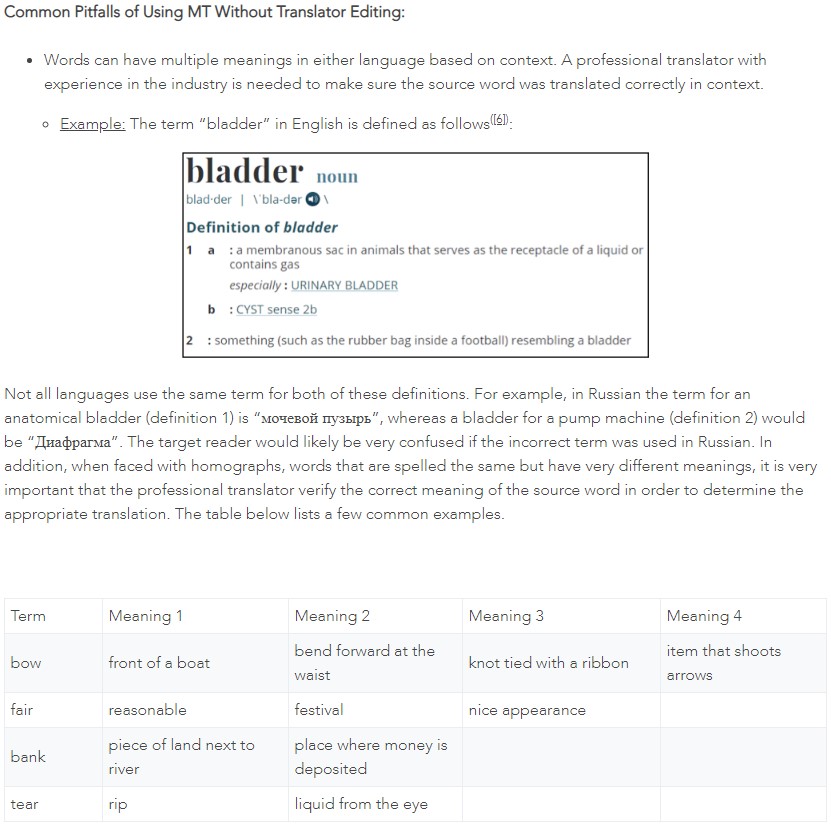
A well-translated website is an impressive way to boost your presence in the international market. A high quality translation will make it easier for new and existing partner organizations and customers to access information about your company, services, and products. This article outlines three essential and integral processes—Translation, Localization, and Customization—along with some helpful tips, for how to build a multilingual website that is not only accurate to the meaning of the original text, but also to the integrity of your brand in the global economy….
Translation
While there are a growing number of free machine translation options that will quickly convert text to the desired target language, the quality cannot be guaranteed unless the translated text is verified by a native speaking translator with expertise in your particular field. Most free translation options contain content from any number of industries, which could lead to confusing mistranslations. From our previous article on machine translations, we shared the following information:

Moreover, using machine translations can hurt search engine optimization (SEO) rankings since Google prefers human-produced data instead of auto-generated content. The more auto-generated content is detected, the greater the penalties[1]. A more strategic approach would be to work with an expert translation provider to produce the translated content, as well as verify that the translations contain key search terms for your industry.
Ultimately, a specialized translation company can provide your website with contextually correct terminology that optimizes your search engine results, as well as develop language that fits your marketing style. This creativity and cultural savviness to spread your message in both another language and another culture is called localization, an essential step that is often overlooked, but can set you apart in the global market.
Localization
Localization is the process of adapting content so that it is “linguistically and culturally appropriate to the region where it will be used and sold”, whereas translation is simply finding the meaning equivalence in the target language[2]. Beyond word choice that best leverages SEO, some important elements to consider when localizing translated content are: treatment of measurements, currency and number formats, capitalization preferences, time and date formats, contact information, etc.
It is also important to take into account the geographical region(s) of your target market, since cultural preferences, terminology, and spelling might change from country to country, region to region. What that means is, instead of simply having your website translated to Spanish, plan out which regions you are trying to reach—Spain? Argentina? Central America? Spanish speakers in the United States? Knowing this will set you up for optimal localization and understanding for your end users since the translation can be catered accordingly. For example, “guagua” means “bus” in the Dominican Republic, Cuba and Puerto Rico, but is a word used for “baby” in Chile. If you are trying to sell busses in Chile, it would be confusing to the locals if “guagua” was accidentally used[3]!
Customization
Your company likely has already spent time cultivating your brand. The efforts of localization that work to convey the tone and message of your brand in the target markets can be maintained through use of Translation Memory, glossaries, and style guides. These resources make it easier to produce consistent, quality content on the front end, and verify your brand’s message comes across as credible and trustworthy to the multilingual audience.
It is also possible to tailor the content of your website even further—for example, consider whether all products and services will be available internationally. If certain products and services are only offered in limited areas, then you could modify the translated website to omit the content entirely or add in a note indicating something along the lines of “Not available in xxxxx”. If you offer free shipping in the United States and have “FREE SHIPPING!” on your products page, determine if this same deal is offered globally or if a different line of text should be translated, such as “Shipping charges applied at checkout”.
Tips for Website Translation
Identify how to extract text from your website
- This will also help you figure out how the translated text will be entered back in. Is it an automated or manual process? Automated extraction/insertion processes tend to be far less time-consuming and costly, as well as reduce the potential for error.
- Find out if your web host supports different characters and fonts used by the languages into which you would be translating.
- Assess how often the content of your website is updated and what that process looks like—what are the timelines, who is involved, and where would translation fit in? Map this out internally and also with the language service company completing the translation to manage expectations and stay on top of deadlines.
Review source text for comprehensiveness and SEO quality before sending out for translation
- When possible, use complete sentences instead of fragments since they allow for the best translation quality.
- Provide explanations for any abbreviations or acronyms either on the website for clarification to all readers or in a glossary for the translator’s reference.
- Include key terms on your website that aim to improve your website’s SEO ranking.
- Determine if graphics need to be translated. If so, are the native files available with editable text, or does the text need to be rekeyed and art recreated for the other languages?
Match existing translated content to improve brand reliability
- Share any existing translated material with the translation company to help improve consistency across mediums. Do you have this text saved in a Translation Memory or glossary? Even better! These resources will help automate the translation process, saving on time and cost.
- Examples where translations may already exist are: manuals, brochures, price lists, etc.
Create a style guide to remain consistent in your localization and creative customizations
- List your preferred treatment of measurements, addresses, terminology, etc.
- Refer to previous translations to match stylization or work with the translation company to identify best practices.
Summary
If you want a high quality website translation to set your company apart in the global market, it is vital to conduct a thorough assessment of what content will be translated, who the target audience will be, and how the process will look. The tips listed above provide a framework for what types of questions go into setting up a successful project. Working with a qualified language service provider with experience in the industry to address these questions will facilitate the process and ensure that the best practices are implemented for translation, localization, and customization.
[1] Why Automatically-Generated Content Won’t Help You Rank, Lian Brooks, https://thecontentworks.uk/automatically-generated-content/
[2] Translation Versus Localization: What’s the Difference?, Nitish Singh, PhD, https://thecontentwrangler.com/2016/06/22/translation-versus-localization/#
[3] Spanish words that have different meanings in different countries, Phiroza Marker, https://www.spanishmarks.com/blog/51-spanish-different-meanings
Back To News
 800-541-8270
800-541-8270